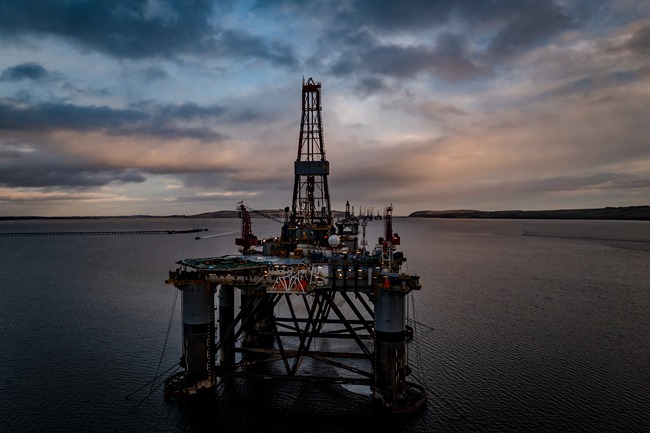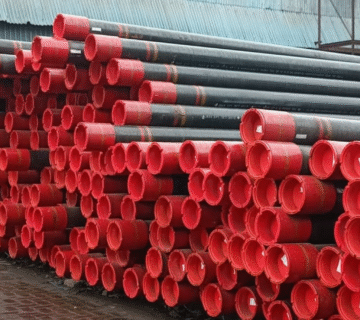Oil drilling is one of the most complex engineering feats in modern industry. Beneath layers of soil, rock, salt, and pressurized formations lie hydrocarbons that fuel economies and shape global energy security. Accessing them requires more than a drill bit — it takes advanced machinery, precise planning, and carefully executed processes designed to balance efficiency with safety.
From choosing the right location to managing downhole pressures thousands of feet below the surface, every step demands accuracy. A single miscalculation can trigger equipment failure, environmental hazards, or financial setbacks. This is why understanding how oil drilling works matters, not only for industry professionals but also for anyone seeking insight into the energy systems that power daily life.
In this guide, we’ll define oil drilling, explain its process, explore offshore complexities, and highlight the equipment that makes it possible.
What is Oil Drilling: Definition and Key Features
Oil drilling is the process of creating a borehole in the earth’s surface to access hydrocarbons such as crude oil and natural gas. These hydrocarbons are often trapped beneath impermeable rock layers and must be reached through carefully engineered drilling operations. The process involves using a drilling rig, specialized tubular goods, and drilling fluids to penetrate subsurface formations safely and efficiently.
At its core, oil drilling is more than simply breaking rock. It is a controlled operation that balances the mechanical act of drilling with pressure management, formation stability, and environmental safeguards.
Key Features of Oil Drilling
- Precision Engineering: Every well is designed with exact specifications for diameter, depth, and casing programs to ensure safety and structural integrity.
- Use of Specialized Equipment: Drill bits, drill pipes, mud pumps, and blowout preventers work together to manage downhole conditions.
- Drilling Fluids: Mud systems are essential for cooling the bit, carrying cuttings, and maintaining pressure balance.
- Casing and Cementing: After sections are drilled, casing is installed and cemented to stabilize the borehole and isolate formations.
- Safety and Control Systems: Blowout preventers and monitoring technologies ensure control of well pressure and prevent catastrophic failures.
Oil Drilling Process (Step by Step)
Oil drilling is a highly engineered sequence that combines geology, mechanical precision, and safety protocols to extract hydrocarbons from deep beneath the Earth. The process unfolds in several key stages:
Step 1: Site Selection and Preparation
Every drilling project begins with choosing the right location. Geologists use seismic surveys, mapping, and exploratory wells to identify hydrocarbon-rich formations. Once confirmed, the site is cleared, leveled, and prepared with access roads, storage areas, and drilling pad foundations. Environmental and regulatory approvals are secured at this stage to ensure compliance with safety and ecological standards.
Step 2: Rig Mobilization and Setup
The drilling rig, complete with derrick, rotary table, drawworks, mud pumps, and power systems, is transported to the location. Crews assemble and test the equipment, especially safety systems like blowout preventers (BOPs), which are critical for controlling unexpected pressure surges. Proper setup ensures the rig can operate reliably under demanding conditions.
Step 3: Spudding the Well
The actual drilling starts with a large-diameter drill bit creating the surface hole. A surface casing is then inserted and cemented to stabilize the shallow section of the well and protect freshwater aquifers. Spudding sets the foundation for deeper drilling operations, giving the well its first level of structural integrity.
Step 4: Drilling in Sections
Deeper drilling is carried out in smaller-diameter stages. Each section is drilled, followed by casing and cementing before moving further down. This step-wise approach manages unstable formations, high-pressure zones, and gas pockets. Throughout this process, drilling mud is circulated to:
- Cool and lubricate the bit
- Carry rock cuttings to the surface
- Control pressure inside the well
- Prevent borehole collapse
Step 5: Casing and Cementing
After drilling each section, steel casing is lowered into the hole and cemented in place. Cement fills the annular space, bonding the casing to the formation, preventing fluid migration, and adding structural support. This step is repeated at every stage until the final depth is reached, ensuring long-term well integrity.
Step 6: Well Logging and Evaluation
Once the target formation is reached, tools are lowered into the borehole to measure porosity, permeability, resistivity, and fluid saturation. These readings help determine whether the formation holds commercially viable hydrocarbons. Accurate logging is critical for deciding if the well should be completed or abandoned.
Step 7: Well Completion
If logging results are positive, the well undergoes completion. This involves installing production tubing, packers, and safety valves. Perforating guns are used to create holes in the casing and cement, connecting the wellbore with the hydrocarbon reservoir. In some cases, stimulation methods like hydraulic fracturing or acidizing are applied to improve reservoir productivity.
Step 8: Production Phase
Hydrocarbons begin to flow from the reservoir through the tubing to the surface. Flow is controlled by a system called the Christmas Tree, a series of valves and fittings designed to regulate pressure and ensure safe operations. The produced oil and gas are then separated, processed, and transported to refineries or storage facilities.
Step 9: Monitoring and Safety Control
Throughout drilling and production, real-time monitoring systems track pressure, mud weight, and equipment performance. Blowout preventers (BOPs) remain on standby to seal the well in case of a sudden influx of fluids. Strict safety protocols are enforced to protect both workers and the environment from accidents or blowouts.
Step 10: Plugging and Abandonment
When a well is no longer productive, it must be safely sealed. Cement plugs are placed in critical zones, and casing is cut below ground level. The site is restored according to environmental regulations, leaving no risk of contamination or pressure leaks.
Offshore and Deepwater Oil Drilling
Drilling offshore introduces an entirely new set of complexities compared to land-based operations. Instead of drilling from a fixed location, rigs must operate on open water, often miles from shore, where environmental forces and logistical constraints are extreme. Offshore drilling enables access to reserves that account for a significant share of the world’s hydrocarbon supply.
Shallow Water Offshore Drilling
In waters up to 400 feet deep, jack-up rigs and platform rigs are commonly used. Jack-up rigs stand on legs that can be lowered to the seabed, providing stability for drilling. These rigs are suitable for coastal reserves and are favored for their relatively lower cost and mobility.
Deepwater Drilling
At depths ranging from 1,000 to 5,000 feet, semi-submersible rigs and drillships become necessary. These floating units rely on sophisticated dynamic positioning systems to maintain stability above the well site. Anchors or computer-controlled thrusters counteract waves, wind, and currents, allowing precision drilling in waters where fixed rigs cannot be deployed.
Ultra-Deepwater Drilling
Beyond 5,000 feet, operations become some of the most challenging engineering projects on Earth. Drillships and advanced semi-submersibles are used, equipped with riser systems to connect the seabed wellhead to the rig. High-pressure, high-temperature environments at these depths demand specialized materials and technologies to ensure safety and efficiency.
Subsea Production Systems
In offshore fields, once a well is completed, subsea equipment such as wellheads, blowout preventers (BOPs), and Christmas Trees are installed directly on the seabed. These systems are remotely operated and designed to withstand corrosive seawater and crushing deep-sea pressures. Oil and gas are transported via risers and pipelines to floating production units or directly to onshore facilities.
Challenges in Offshore Drilling
- Logistics: Transporting equipment, personnel, and supplies requires support vessels and helicopters.
- Environmental Risks: Oil spills and blowouts can have catastrophic ecological impacts, demanding stringent safeguards.
- Cost: Offshore projects are among the most capital-intensive, often requiring billions of dollars in investment.
- Weather: Rigs must withstand storms, hurricanes, and unpredictable ocean conditions without halting operations.
Offshore and deepwater drilling represent the frontier of hydrocarbon exploration, combining advanced engineering, precision logistics, and uncompromising safety standards to access energy resources beneath the oceans.
Things To Keep In Mind
Oil drilling is a complex undertaking that requires meticulous planning, engineering precision, and strict adherence to safety and environmental standards. Several key considerations influence the success and sustainability of a drilling project:
1. Geological Survey and Site Selection
Before any rig is mobilized, a thorough subsurface survey is essential. Seismic imaging and exploratory studies help identify hydrocarbon-bearing formations, their depth, and surrounding geological challenges. Poor site selection can lead to dry wells or unstable drilling conditions, causing major financial losses.
2. Drilling Fluid Design
Drilling fluids, or “mud,” play a vital role in stabilizing the borehole, cooling the drill bit, and transporting cuttings to the surface. The right formulation—whether water-based, oil-based, or synthetic—depends on formation characteristics, temperature, and pressure. Incorrect fluid design can cause blowouts, stuck pipe, or well collapse.
3. Equipment Compatibility
Every well has unique requirements, making equipment selection critical. From drill pipe sizes and casing grades to blowout preventers (BOPs) and mud pumps, all components must align with expected pressures, depths, and environmental conditions. Compatibility ensures smooth drilling operations and minimizes costly downtime.
4. Safety and Blowout Prevention
Well control is non-negotiable. Blowout preventers, emergency shut-down systems, and strict operational protocols safeguard workers, equipment, and the environment. Regular safety drills and real-time monitoring of pressure anomalies are necessary to reduce the risk of catastrophic incidents.
5. Environmental Protection
Drilling projects, especially offshore, must comply with stringent environmental regulations. Measures like spill containment systems, cuttings reinjection, and low-toxicity drilling additives help minimize ecological impact. Operators must balance energy needs with sustainability goals.
6. Cost and Logistics Management
Oil drilling is one of the most capital-intensive operations in the energy sector. Effective logistics—covering transportation, warehousing, and supply chain reliability—can drastically influence costs. Mismanaged logistics often delay projects and inflate budgets.
7. Skilled Workforce and Training
Operating advanced rigs, handling high-pressure systems, and maintaining equipment require highly skilled professionals. Continuous training ensures personnel can adapt to evolving drilling technologies and safety standards.
8. Post-Drilling Evaluation
Even after drilling, well integrity must be assessed. Cement bonding, casing inspection, and production testing confirm whether the well is safe, stable, and capable of long-term production.
Oil Drilling Equipment and Solutions To Streamline Operations
The efficiency of any oil drilling project rests on the strength and reliability of its equipment. Every stage — from penetrating formations to stabilizing wells and ensuring safe hydrocarbon flow — depends on tools designed to withstand pressure, heat, and geological challenges.
AZM Oilfield provides a complete range of solutions to address these challenges. Our portfolio covers OCTG products, drill pipes, drilling lubricants, and fluid chemicals, each rigorously tested and field-proven to meet international standards.
With global logistics expertise, warehousing in the UAE and Egypt, and decades of oilfield knowledge, AZM Oilfield ensures seamless supply and support. Partnering with us means achieving streamlined drilling operations with equipment you can trust.
Frequently Asked Questions
Offshore drilling involves extracting oil and gas from beneath the ocean floor. Large platforms or rigs are anchored at sea, where drilling equipment bores through layers of rock under the seabed. Once oil or gas is located, wells are secured with pipes and cement, and the resources are pumped to the surface. Specialized ships or pipelines then transport the extracted materials to refineries for processing.
An oil drill bit is a cutting tool attached to the end of a drill string. As it rotates, its hardened teeth or cutters grind, crush, and shear rock layers beneath the earth’s surface. Drilling fluid, called “mud,” is circulated through the bit to cool it, remove cuttings, and maintain pressure. This continuous process allows the well to reach deeper reservoirs of oil or gas efficiently.
Oil drilling is the process of creating a borehole in the earth to access petroleum reserves. It uses specialized machinery to penetrate layers of soil and rock until reaching underground reservoirs. The operation includes drilling, installing casing to stabilize the well, and using pumps to bring crude oil to the surface. The crude is then transported to refineries, where it is processed into fuels and other products.



